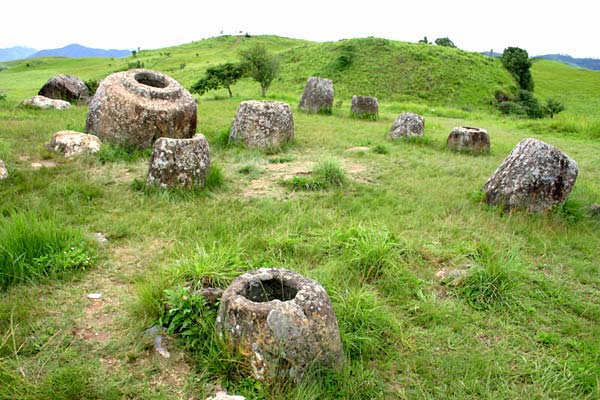Plain of Jars
The Plain of Jars is a large area extending around Phonsavan from the southwest to the northeast, where huge jars of unknown origin are scattered about in over a dozen groupings. Despite local myth, the jars have been fashioned from solid stone, most from a tertiary conglomerate known as molasse (akin to sandstone), and a few from granite. ‘Quarries’ (actually boulder fields) west of Muang Sui have been discovered containing half-finished jars. Apparently the jars were carved from solid boulders of varying sizes, which goes a long way to explain the many different sizes and shapes.
Many of the smaller jars have been taken away by various collectors, but there are still several hundred or so on the plain in the five major sites (out of the 20 or so known to exist) that are worth visiting.
Site 1 (Thong Hai Hin; admission US$0.70), the biggest and most accessible site, is 15km southwest of Phonsavan and features 250 jars, most weighing 600kg to one tonne each. The largest jar weighs as much as six tonnes and is said to have been the victory cup of mythical King Jeuam and so is called Hai Jeuam. The site has two pavilions and restrooms that were built for a visit by Thailand’s crown prince.
Two other jar sites are readily accessible by road from Phonsavan.
Site 2 (Hai Hin Phu Salato; admission US$0.70), about 25km south of town, features 90 jars spread out across two adjacent hillsides. Vehicles can reach the base of the hills, so it’s only a short if steep walk to the jars.
More impressive is 150-jar Site 3 (Hai Hin Lat Khai; admission US$0.70). It’s about 10km south of Site 2 (or 35km from Phonsavan) on a scenic hill-top near Lat Khai, southeast of Phonsavan. Ban Xieng Di contains a small monastery where the remains of Buddha images that were damaged in the war have been displayed. The villagers, who live in unusually large houses compared with those of the average lowland Lao, grow rice, sugar cane, avocado and banana. Villagers can lead you on a short hike to a local waterfall called Tat Lang (admission US$0.50). To reach the jar site you must hike around 2km along rice paddy dykes and up the hill.
Many smaller sites can also be seen in Muang Kham district, but none of them contain more than 40 or so jars. Only Sites 1, 2 and 3 are considered to be reasonably free of UXO. Even at these sites you should take care to stay within the jar areas and stick to worn footpaths.
Source: lonelyplanet.com

